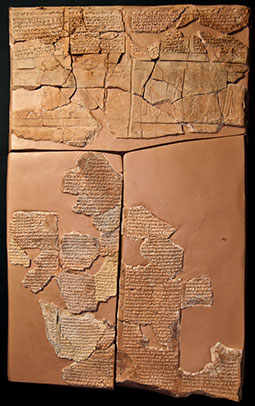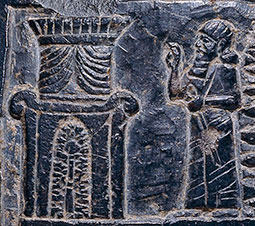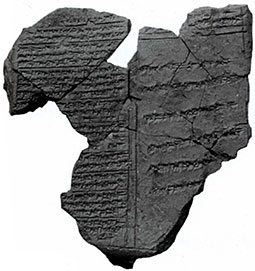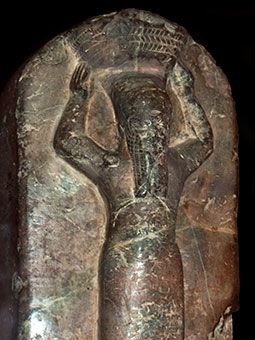The Succession Treaties of Esarhaddon
"Swear by Aššur, father of the gods, lord of all the lands!" So commanded king Esarhaddon in the spring of 672 BC, as he bound the inhabitants of the Assyrian empire to ensure the succession TT of his son, Assurbanipal. Experience had shown him that the change of rule from one king to the next was a dangerous time. Vassals TT would seek to regain their independence, and rival claimants to the throne could plunge the country into civil war. Treaties were a long-established method of controlling the behaviour of key figures at moments like this. Copies of Esarhaddon's Succession Treaty (previously referred to as the 'Vassal Treaty') found at Nimrud reveal the king's plans for securing the empire after his death.
The Succession Treaties in historical context: transfer of power

Image 1: A copy of the great Succession Treaty drawn up by king Esarhaddon PGP of Assyria in 672 BC. This tablet has been extensively restored from fragments found in the throne room of Nabu's temple at Kalhu, and much of the text is missing. BM 132548. View large image on British Museum website. © The Trustees of the British Museum.
In 672 BC the ageing king Esarhaddon put into effect a strategy for his succession. One son – Assurbanipal PGP – would become the next king of Assyria; under him, his older brother – Šamaš-šumu-ukin PGP – would become king of Babylon.
Esarhaddon's own ascent to the throne was not straightforward, even though he had been made crown prince TT by his father, king Sennacherib PGP . Intrigues made him flee the royal court. In 681 BC Sennacherib was murdered by other sons who tried to seize the throne for themselves. Esarhaddon took back his rightful place through force of arms.
Esarhaddon was desperate to avoid a repeat of this turmoil. He gathered key figures from across his empire to support his succession plan. Many of the partners listed on the preserved treaties (Image 1) were rulers of eastern lands that had only recently been brought back into the Assyrian empire.
According to Assurbanipal, the treaty was sworn on the 12th of Ayyar (March/April) 672 BC. The surviving copies are dated to the 16th or 18th, however. We might perhaps imagine that it took several days for so many people to swear such a long oath according to proper procedures.
Treaties in Assyria

Image 2: Detail from Esarhaddon's monument recording the restoration of Babylon. BM 91027. View large image on British Museum website. © The Trustees of the British Museum.
International treaties were nothing new. Many are known from ancient Mesopotamia, stretching back for almost 2,000 years before Esarhaddon's Succession Treaty. This is all the more remarkable given that very few treaties have survived from elsewhere in the ancient world. The Mesopotamian habit of writing on clay has preserved once again for us original documents that yield first hand testimony as to how the ancient world actually worked.
The king of Assyria made treaties both with equals and with those in much weaker positions. What seem to us to be one-sided treaties were often made at the request of the weaker party. In return for tribute to Assyria and obedience to its rulers, vassals gained the protection of one of the most powerful empires in the world. Assyrian weapons and fear of the royal wrath strengthened vassal rulers against hostile neighbours and rival claimants to the throne.
Esarhaddon's Succession Treaty is the longest Assyrian treaty known. It sets out in detail the many actions required of his subjects, secured by a long list of fearful curses for anyone who might dare to break their oath. The full text and translation is available online (SAA 2: 006).
» See the Succession Treaty of Esarhaddon in more detail
Did the treaty work?
Three years after the treaty was made, Esarhaddon died. As he had hoped, Assurbanipal took the Assyrian throne, and his brother Šamaš-šumu-ukin the Babylonian throne (Image 3). All was well. The treaty had done its job. Assurbanipal remarked in his annals:
Esarhaddon, king of Assyria, my father and begetter, heeded the command of Aššur and Mullissu PGP , the gods in whom he trusted, who told him that I was to exercise the kingship. On 12th of Ayyar, at the noble command of Aššur, Mullissu, Sin PGP , Šamaš PGP , Adad PGP , Bel PGP , Nabu, Ištar of Nineveh PGP , Ištar of Arbela PGP , Ninurta, Nergal PGP and Nusku PGP , he convened the people of Assyria, great and small, from coast to coast, made them swear a treaty oath by the gods, and made a binding agreement to protect my crown-princeship TT and future kingship over Assyria.
But the situation could not last. Control of Babylon had always been a problem for the Assyrians. Over the years they had tried many approaches, but none had worked for long. In 652 BC, brother turned on brother. Šamaš-šumu-ukin made a bid for independence, and the empire was plunged once more into a long and bloody civil war. Later legend told of the death of the decadent king Sardanapalus PGP in the flames of his burning palace. The name Sardanapalus seems to derive from that of Assurbanipal. But the fiery death matches the fate suffered by his brother Šamaš-šumu-ukin when Assyrian troops finally defeated his rebellion.
Where were the treaty tablets found?

Image 4: The reverse TT of a fragmentary Succession Treaty tablet TT from Nabu's temple in Kalhu. The scribal colophon TT , in the lower right corner of the tablet, records the nature and date of the text: "The treaty which Esarhaddon, king of Assyria, concluded on behalf of Assurbanipal, the great crown prince TT designate of Assyria, and Šamaš-šumu-ukin, crown prince designate of Babylon". ND 4336c; Iraq Museum, Baghdad. British Museum photograph © The Trustees of the British Museum.
The exceptionally long and detailed treaty imposed by Esarhaddon is known from at least 10 copies, each of which was sworn by a different vassal or province TT . Such a long and important text required equally grand clay tablets TT . Each was certified by the impression TT of no fewer than three seals of Aššur, head of the Assyrian pantheon, and had been stored under divine protection.
In the 1950s, excavators from the British School of Archaeology in Iraq TT found 8 copies of the treaty in the throne room of the temple of Nabu at Kalhu. This was a meaningful home. Nabu, god of writing, had a significant library in his temple; he was also thought to be the divine scribe TT of the Tablet of Destinies TT . It is not certain that the treaties had originally been stored there, however. The treaty was sworn across the empire, yet the only copies found are those imposed on the tribes to the east of Assyria, from Media PGP , Ellipi PGP and Zamua PGP . Did the Medes who sacked Kalhu in 612 BC bring them to the throne room to be ceremonially smashed?
Three fragments (perhaps from a single copy) of the treaty were excavated at the important Assyrian city ofAssur PGP (modern Qala'at Sherqat) between 1903 and 1914, although frustratingly it is not known where on the site they were found. More recently, a badly broken copy of the treaty was excavated at Tell Tayinat (in modern Turkey) in 2009 (1). The tablet was found in the ruins of the temple, where it had shattered on the floor during the final destruction. Tayinat was once the capital of the Assyrian province TT of Kullania. The find shows that the Succession Treaty was not imposed only on Assyria's vassals, as was previously thought. Rather, it was administered to Assyrians and subjugated peoples alike, in a large-scale public ceremony which took place over several days.
Content last modified: 18 Dec 2019.
References
- Harrison, T.P. and J.F. Osborne, 2012. "Building XVI and the Neo-Assyrian sacred precinct at Tell Tayinat", Journal of Cuneiform Studies 64, pp. 125-143 (PDF available via JSTOR for subscribers). (Find in text ^)
Further reading
- Fales, F.M., 2012. "After Ta'yinat: the new status of Esarhaddon's adê for Assyrian political history", Revue d'Assyriologie 106, pp. 133-158.
- George, A.R., 1986. "Sennacherib and the Tablet of Destinies", Iraq 48, pp. 133-146 (PDF available via JSTOR for subscribers).
- Lauinger, J., 2012. "Esarhaddon's Succession Treaty at Tell Tayinat: Text and Commentary", Journal of Cuneiform Studies 64, pp. 87-123 (PDF available via JSTOR for subscribers).
- Mallowan, M.E.L., 1956. Twenty-five years of Mesopotamian discovery, 1932-1956, London: British School of Archaeology in Iraq.
- Parpola, S. and K. Watanabe, 1988. Neo-Assyrian Treaties and Loyalty Oaths (State Archives of Assyria 2), Helsinki: Helsinki University Press.
- Watanabe, K., 1987. Die adê-Vereidigung anläßlich der Thronfolgeregelung Asarhaddons (Baghdader Mitteilungen Beiheft 3), Berlin: Gebr. Mann.
- Wiseman, D. J., 1958. "The vassal-treaties of Esarhaddon", Iraq 20, pp. 1–99 and plates (PDF available via JSTOR for subscribers).
Jonathan Taylor
Jonathan Taylor, 'The Succession Treaties of Esarhaddon', Nimrud: Materialities of Assyrian Knowledge Production, The Nimrud Project at Oracc.org, 2019 [http://oracc.museum.upenn.edu/nimrud/livesofobjects/successiontreaties/]
